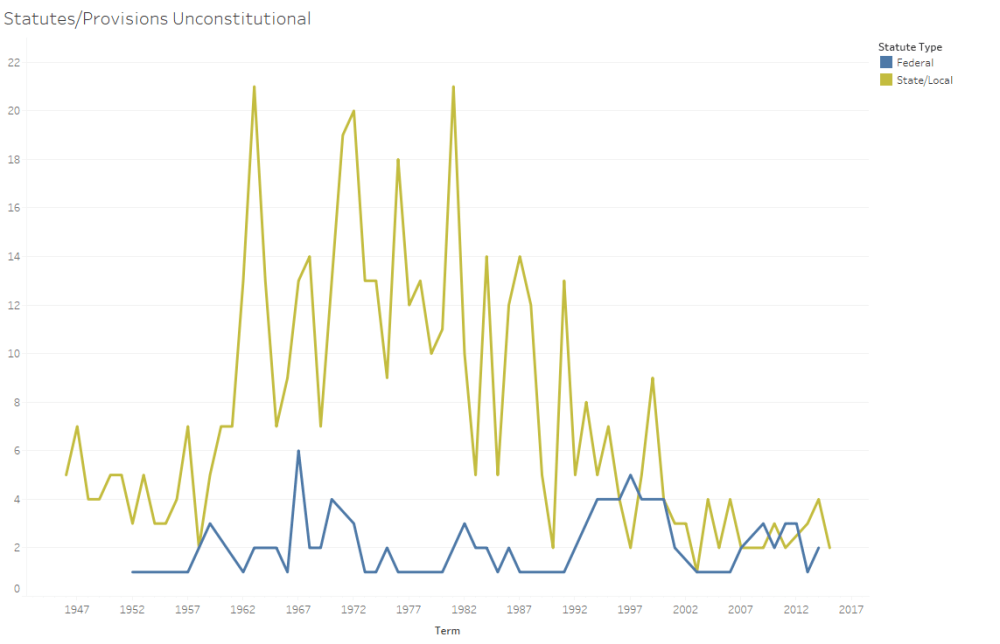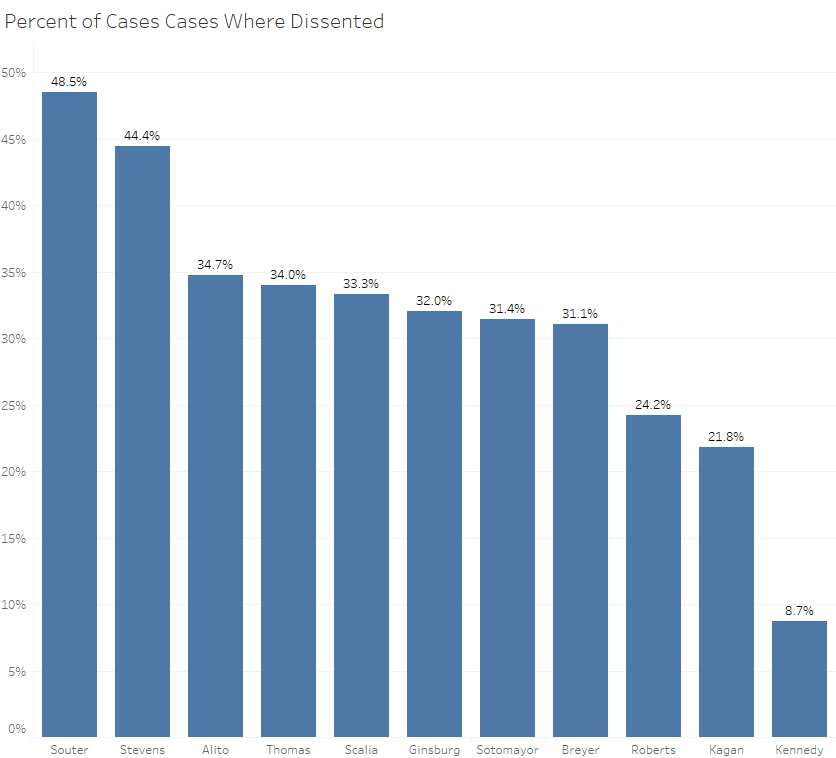“[I]f a law be in opposition to the Constitution, if both the law and the Constitution apply to a particular case, so that the Court must either decide that case conformably to the law, disregarding the Constitution, or conformably to the Constitution, disregarding the law, the Court must determine which of these conflicting rules governs the case. This is of the very essence of judicial duty.”
Marbury v. Madison (1803)
The Supreme Court is charged with the duty of ensuring laws do not abridge the Constitution. This duty may compose a large part of the Court’s work or it may make up only a portion. The following figure shows the number of cases where the Court ruled laws unconstitutional between 1946 and 2015.

Many cases in the public spotlight, from Citizens United v. FEC to District of Columbia Heller to Shelby County v. Holder, fall into this category. As the figure above shows (1) the Court examines statutes from all levels of government, (2) over recent years the Court has ruled many fewer statutes unconstitutional than in the past, and (3) recently the Court has ruled similar numbers of state and federal laws unconstitutional. Since 2005, some of the statute types that the Court has examined multiple times include:

Spotlighting the Roberts Court, decisions that struck down statutes based on their constitutionality break down as follows:

While there is a fair amount of information available on laws the Court has held unconstitutional (the data in this post incorporates the Supreme Court Database’s coverage of cases where the Court has ruled laws unconstitutional and codes all decisions examining statutes’ constitutionality since 2005), there is less so available on laws the Court has upheld. In the recent case Beckles v. United States for example the Court noted the constitutionality of the of the Sentencing Guidelines residual clause: “Because the advisory Sentencing Guidelines are not subject to a due process vagueness challenge, §4B1.2(a)’s residual clause is not void for vagueness.”
The Court ruled on the constitutionality of several federal statutes this past term. These include ruling statutes unconstitutional in Sessions v. Morales-Santana (“The gender-based distinction infecting §§1401(a)(7) and 1409(a) and (c), we hold, violates the equal protection principle, as the Court of Appeals correctly ruled”) and in Packingham v. North Carolina (“It is well established that, as a general rule, the Government “may not suppress lawful speech as the means to suppress unlawful speech.” Ashcroft v. Free Speech Coalition, 535 U. S., at 255. That is what North Carolina has done here. Its law must be held invalid.”)
The constitutional provisions brought into question in such cases since 2005 tend to cluster together with the most challenges under the First Amendment.

First Amendment challenges cover broad terrain from campaign finance to freedom of religion cases and since 2005 the Court has split on these decisions ruling sixteen statutes constitutional and sixteen unconstitutional. 14th Amendment cases in the post include a caveat. While the 14th Amendment applies several of the first ten amendments to the states, the focus of 14th Amendment in this post is with cases that challenge laws on equal protection and privileges and immunity grounds
“All persons born or naturalized in the United States and subject to the jurisdiction thereof, are citizens of the United States and of the State wherein they reside. No State shall make or enforce any law which shall abridge the privileges or immunities of citizens of the United States; nor shall any State deprive any person of life, liberty, or property, without due process of law; nor deny to any person within its jurisdiction the equal protection of the laws.”
Beckles, Packingham, and Morales-Santana were all decided by unanimous Courts. Delving a little deeper into this terrain, however, the Court is quite divided. The justices’ dissents (or dissents they joined) in these cases give a sense of their disagreement with the Court’s decisions. The Roberts Court justices’ frequencies of dissents in this set of cases are

As there was more dissension in this set of cases earlier in the Roberts Court, the liberal justices from the earlier years were the most prominent dissenters. After these justices, the justices’ dissenting frequencies are relatively similar until reaching the three Roberts Court justices that dissent the least overall – Justices Kennedy, Kagan, and Chief Justice Roberts.
Looking at the raw number of dissents the ordering of the justices shifts

While Justice Thomas dissented more often when the Court upheld a law than when it invalidated one, Justice Kennedy is on the other end of the spectrum. Justices Stevens and Souter, the two most frequent dissenters, also dissented more often when the Court upheld statutes.
Looking at the dissenting coalitions, many of these cases caused ideological splits in the Court and led to 5-4 decisions. The ideological fractures are evident from the figure below

Given the Court’s conservative base it may not be surprising that liberal dissents in 5-4 cases outweighed conservative ones. The Court’s liberal wing dissented more frequently in 5-4 splits both when the Court held statutes constitutional and when the Court held statutes unconstitutional.
While the Court maintained a tenuous balance with an eight-justice composition for most of last term that cohesion will likely not hold moving forward. With Justice Gorsuch, the Court now has what looks to be another clear left-right split that may lead to more closely divided decisions on the constitutionality of state and federal laws. The Court has no shortage of such highly charged material this coming term with the travel ban case, a major redistricting case that will take into account a state’s election district design, and a case challenging a public accommodations statute on First Amendment grounds that may help define states’ laws in this area for years to come. Much will hinge on Justice Kennedy votes in these cases and any further shift in the Court’s balance will inevitably lead to more such challenges to statutes and very likely to more conservative victories.
On Twitter: @AdamSFeldman
7 Comments Add yours